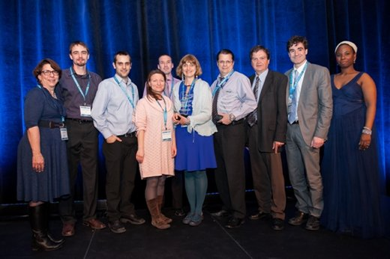
The Consortium for Research and Innovation in Aerospace in Québec (CRIAQ) that launched its 100 project this year, organized its Gala in last April, where the projects funded by CRIAQ were presented using posters and films,, most of them were done by students working on these projects. Among these projects realized in Canada, one international project has also been awarded..
The main objective of the teams working on the international (Canada-Italy) project CRIAQ MDO-505 is to design and manufacture a morphing wing tip for a Bombardier-type aircraft controlled by electric actuators and pressure sensors. The title of the CRIAQ MDO-505 project is Morphing Architectures and related Technologies to improve the Wings Efficiency of the Wings.
This project, taking place over three years, 2012-2015, represents a continuation of CRIAQ 7.1, a project carried out from 2006 to 2009 and in which a morphing wing was controlled by the use of smart material actuators. The morphing wing was equipped with a composite skin and Kulite pressure sensors for transition detection, a design that successfully delayed the flow transition.
The Canadian partners in the current international project are Bombardier Aerospace, Thales Canada, IAR-NRC, ETS, and Ecole Polytechnique, and the Italian partners are Alenia, CIRA and the University of Naples. The objectives of the desired morphing behavior are to delay the flow transition on the wing and to thereby improve aerodynamic performances of the aileron. The aerodynamic numerical results will be validated using wind tunnel tests in the IAR-NRC Subsonic Wind Tunnel. The Canadian team obtained the runner-up CRIAQ Award in April 2014. The leaders (and some student members) of the Canadian team are featured in the picture below. The total cost of this 3-year international project is around 3 million dollars.
Preliminary controller tests have been carried out at the Laboratory of Applied Research in Active Controls, Avionics and AeroServoElasticity (LARCASE), in the Price-Païdoussis Blow-Down Subsonic Wind Tunnel, and the wing and the aileron designs have been finalized. The actuators were designed and manufactured at ÉTS, and the tests of the morphing wing prototype are being carried out on a bench manufactured at ÉTS. Starting in the fall of 2014, three series of tests will be carried out in the IAR-NRC Subsonic Wind Tunnel. The goal is to apply this new technology to a wing equipped with an aileron on a Bombardier aircraft with the objective of reducing aircraft fuel consumption.
The team was ranked 2nd in the Poster Competition and Prototypes award of “CRIAQ projects underway and completed” at the Gala of the Consortium for Research and Innovation in Aerospace in Quebec (CRIAQ) in April 2014. This award recognized the excellence of the work and the level of collaborations between the project’s team members: Professors Ruxandra Botez and Dr Simon Joncas of ETS, Professor Eric Laurendeau of École Polytechnique, Norman Ball, Erik Sherwood and Mahmoud Mamou from the Institute for Aerospace Research – National Research Council (NRC), Philippe Molaret from Thales Canada, and Patrick Germain and Kafyeke Fassi from Bombardier Aerospace. Many students and postdoctoral researchers are also working on this project.
From the left: Pamela Moss, IAR-NRC, François Michaud and David Barry, Masters students, Andreea Koreanschi, PhD student, Simon Joncas and Ruxandra Botez (academic leader), professors from the Automated Production Engineering Dept, ETS, Patrick Germain (industrial leader), Bombardier Aerospace, Philippe Molaret, Thales Canada, Eric Laurendeau, Professor of Mechanical Engineering, École Polytechnique, and Nataly Désir, Master of Ceremonies.
Realized over three years, between 2012 and 2015, this multidisciplinary project was funded in Canada by Thales Canada, Bombardier Aerospace, the CRIAQ and the National Sciences and Engineering Research Council of Canada (NSERC).
Dr Ruxandra Botez, Full Professor at ETS since 1998, obtained her PhD from McGill University (1994), her Master from Ecole Polytechnique (1989) and her B.Sc.A from the Faculty of Aircraft Design in Bucharest, Romania (1984). She worked at the aeronautical company ICA-Brasov in Romania (1984-1987), a
Commentaires